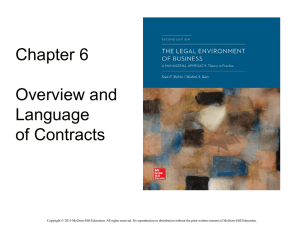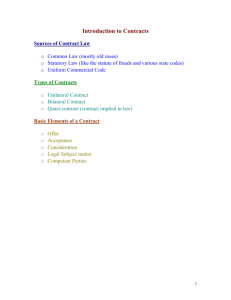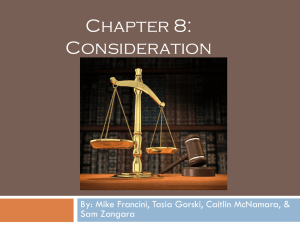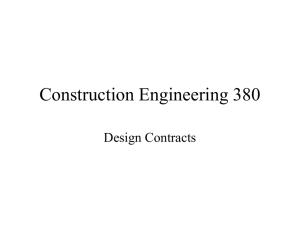Introduction to Contract Law and Contract Theory
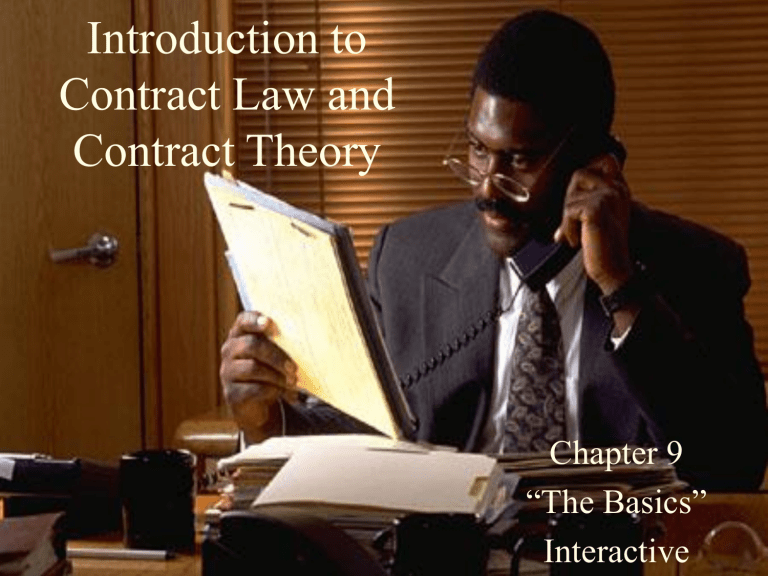
Introduction to
Contract Law and
Contract Theory
Chapter 9
“The Basics”
Interactive
WOULD YOU TRUST
THIS GUY?
You’ve asked him to put the agreement in writing…
His response is, “Trust me.”
You’ve asked him to sign a contract that your lawyer has prepared…
His response, “Let’s shake on it. After all, my word is as strong as oak!”
WOULD YOU TRUST
THIS GUY?
You’ve asked him to put the agreement in writing…
His response is, “Trust me.”
You’ve asked him to sign a contract that your lawyer has prepared…
His response, “Don’t worry! I won’t let you down!”
Looks Can Be Deceiving!
• Don’t base your trust on how someone looks!
• Just because you think the person is trustworthy and honest, does not mean an agreement shouldn’t be in writing.
• Just because the person attends church or belongs to a certain reputable club in town, does not mean an agreement shouldn’t be placed in writing!
•
YOU CAN BE FOOLED!
“If it’s not in writing, it’s not worth the paper it’s written on…”
Lee Patterson, Esq.
Sonnenshine, Nath and Rosenthal
Los Angeles, California
Defining a Contract &
Contract Terminology
Defining a Contract
• A Contract is a legally binding and legally enforceable promise, or set of promises, between two or more competent parties.
• A contract creates binding economic obligations on both sides.
• It is:
“An Agreement with consideration”
Consideration – Something bargained for and given in exchange for a promise.
Contract Validation
1. Founded on an agreement (I.e., an offer and an acceptance)
2. Supported by consideration
3. Made by parties having the capacity to contract
4. Based on genuine assent
5. Grounded in a legal undertaking
6. Expressed in proper form
Contract Terminology
• The person who makes an offer = Offeror
• The person to whom the offer is made = offeree.
• Unilateral Contract – A promise on one side only.
• Bilateral Contract – Promises on both sides.
Contract Terminology Continued
• Valid Contract – Legally binding and enforceable.
• Voidable Contract – Contract is one that may either be affirmed or rejected at the option of one or more of the contracting parties.
• Void agreements – Unenforceable because they lack one or more of the essential elements of a contract.
Contract Terminology Continued
• Executory Contract – One in which some condition or promise remains unfulfilled by one or more of the parties.
• Executed contract – One in which the parties have fully completed or performed all conditions or promises set out in the agreement.
Contract Terminology Continued
•
Quasi Contract
– Implied Contract
•
Unjust Enrichment –
One party benefits from another (generally monetary in value), without the proper consent of the other, (quasi contract). The benefiting party has received an
“unjust enrichment.”
The other party seeks restitution from the benefiting party.
When Must It Be in Writing?
Contracts Generally Required to be in Writing
• Contracts involving interests in land
• Contracts that by their own terms cannot possibly be performed within one year
• Collateral contracts where a person promises to answer for the debt or duty of another
• Promises made in consideration of marriage
• Contracts for the sale of goods for more than
$500
• Real estate agents’ contracts
Contracts Generally Required to be in Writing (cont.)
• Agents’ contracts where the underlying contract must be in writing
• Promises to write a will
• Contracts to pay debts barred by the Statute of
Limitations or discharged in bankruptcy
• Contracts to pay compensation for services rendered in negotiating the purchase of a business
• Finder’s fee contracts
Types of Contracts
Elements of an Enforceable
Contract
• Agreement
• Consideration
• Contractual capacity
• Lawful object
Sources of Contract Law
• Common law of contracts
• Uniform Commercial Code
• Restatement of the Law of
Contracts Clarifying and synthesizing the common law applicable to the legal profession.
Classifications of Contracts
• Bilateral and unilateral contracts
• Express and implied contracts
• Formal and informal contracts
• Executed and executory contracts
• Valid, void, voidable, and unenforceable contracts
Real Estate Transactions
Transfer of Interests in Real Property Must be in Writing under the Statute of Frauds
This includes:
• Transfers of an ownership interest
• Mortgages
• Leases
• Life estates
• Easements
Parol Evidence
•
Parol Evidence: Oral Statements
•
Parol Evidence Rule: A rule stating that when contracts are in writing, only the writing can be used to show the terms of the contract.
Exceptions to the
Parol Evidence Rule
Parol evidence may be admitted in court if it:
• Shows that a contract is void or voidable
• Explains ambiguous language
• Concerns a prior course of dealing or course of performance between the parties or usage of trade
• Fills in the gaps in a contract
• Corrects an obvious clerical or typographical error
Contracts In Proper Form
FROM A VISUAL STANDPOINT
For Created Contracts
Form of Acceptance
• The form of the acceptance that is demanded determines whether the contract is a unilateral contract (a promise on one side only) or bilateral
(promises on both sides)
Aesthetic Details for Created Contracts
• Computer generated (typed)
• Clean and neat – no marks, folds or other.
• Legal size 11x17 or letter size 8 ½ x 11
• Font size (letter size) in 12pt font
• Times New Roman or Arial style preferred.
• White paper preferred.
• Must be clearly defined by law.
• Contract Parties defined
• Signature area must be laid out so that every signature is readable.
• Pre-Printed signatures.
Language and Fonts
LANGUAGE:
• Written language? Is it clear and definable?
• Is it clear from a legal standpoint?
• Will it hold up in a court of law?
• Has it been reviewed by counsel?
• Was it a boiler-plate contract or written specifically for the purpose of this agreement?
• Is all the language of the contract (Written word) visible to both parties?
Language and Fonts (Continued)
FONT:
• Font Color:
– To the third party, all payments shall be paid.
• Font Style:
To the third party, all payments shall be paid
• Font Size: “Fine Print”
To the third party, all payments shall be paid
Websites to View:
http://www.quickforms.net
http://www.lawstudents.org/contracts http://mycounsel.com
http://fatty.law.cornell.edu/topics/contracts.html
Manager’s Book Shelf
Essentials of Contract Law by Martin A. Frey , Phyllis Hurley Frey , Terry H. Bitting
Law of Peoples by John Rawls , John Rawls
The Complete Guide to Contract Lawyering :
What Every Lawyer and Law Firm Needs to
Know About Temporary Legal Services by Deborah Arron , Deborah Guyol
Kirsch's Guide to the Book Contract : For
Authors, Publishers, Editors and Agents by Jonathan Kirsch
All of these titles are available through Amazon.com
Classification of
Contracts
Group Exercise:
1.
In groups of 2 – 3, read the classifications on page 261.
2.
After reading the types of contracts and the definitions, as a group discuss the definitions and come up with a different example for each of the types of contract listed.
3.
Each group will turn in one sheet with their group examples. Make sure everyone’s name is on the sheet in the upper right hand corner.
4.
You have 40 minutes to complete this exercise.
Introduction to
Contract Law and
Contract Theory
End Chapter 9
Interactive
